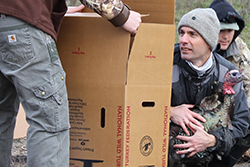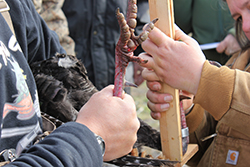
Tim Hermansen of CDFW carries a turkey holding box to CDFW’s Levi Sousa while John Davis clears the net.

Derek Schiewek of CDFW holds a turkey while CDFW’s Laura Cockrell measures the tarsus.
Recent efforts to determine the number of turkeys on the Upper Butte Wildlife Area have been a net success.
CDFW staff and volunteers from the National Wild Turkey Federation (NWTF) began annual turkey banding efforts in 2015 to gather information about turkey demographics and movements to facilitate better management of the population and assess future hunting opportunities. Approximately a dozen volunteers and staff have since worked on this effort two months each year, in the late winter through early spring.
Captured birds are fitted with a numbered band, and their age, gender and weight are determined before they are released. The number of times a turkey is recaptured through ongoing trapping activities, or when a hunter returns a band to CDFW, provides data about the density and the movements of the birds. Approximately 20 wild turkeys have been captured each of the past four years, using air cannons that propel nets. Last year was the sole exception, as torrential storms resulted in zero captures because portions of the property were flooded and could not be traversed with trapping equipment.
“That year was very frustrating, but part of being a wildlife biologist is going with the flow,” recalled CDFW Environmental Scientist Laura Cockrell, who is involved in coordinating and facilitating wildlife surveys on the wildlife area.
This year, walk-in traps were used for the first time to supplement the traditional use of air cannons, and the final tally was 38 turkeys banded, increasing the total number banded over the course of the project to 88. This baseline data will inform decisions on how many turkey hunters will be allowed access to the wildlife area each spring.
“Our volunteers and all our staff are what makes this project successful,” Cockrell said. “Everyone completes a safety training so we can make sure the birds are handled quickly and carefully, and then it is a lot of ‘hurry up and wait’ during the trapping operations. If we did not have a dedicated crew on this project, it would not be successful. The walk-in traps allow staff to set up trapping operations in the morning, check the site throughout the day, and process birds as they are captured.”
Also appreciative of the banding efforts were turkey hunters, who had an extra “spring” in their step this year at the Upper Butte Wildlife Area.
The 2018 spring turkey hunts recently ended after 64 hunters who hunted on Upper Butte Basin harvested 35 turkeys. During the previous three spring seasons combined since spring turkey hunts began on the wildlife area in 2015, 133 hunters participated and 47 turkeys were harvested.
All the result of field conversations between CDFW staff and fall turkey hunters.
“During the fall turkey seasons some years back, hunters at the check stations would frequently ask us when we were going to offer a spring season, which we had not done before,” Cockrell said.
At the wildlife area’s Howard Slough and Little Dry Creek units, the problem was not a lack of turkeys but rather a lack of funding to hire staff to advertise, prepare, regulate and operate the extra hunts – and a lack of scientific data to support an extra hunting season.
A collaborative effort between CDFW and the NWTF solved that problem.
In 2014, NWTF applied for and received a state grant from the Upland Game Bird Stamp Fund. The grant proposal, which was spearheaded by NWTF District Biologist Kevin Vella, obtained five years of funding to support a seasonal coordinator position.
“This spring we had almost 1,800 applications for 144 open spots,” said Cockrell. “Our hunters really appreciate the opportunities that the spring turkey hunts provide. We frequently hear after a hunt what an amazing time they had out in the field and how much they enjoyed their time on the wildlife area. One of our hunters this season was so excited because he was able to harvest a nice turkey at his very first hunt!”
All photos © National Wild Turkey Federation, all rights reserved. Top Photo: Tim Hermansen of CDFW holds a turkey while Laura Cockrell of CDFW measures its beard with calipers.